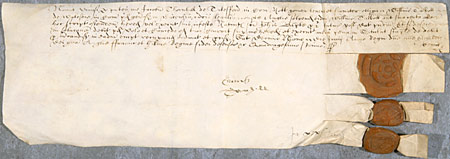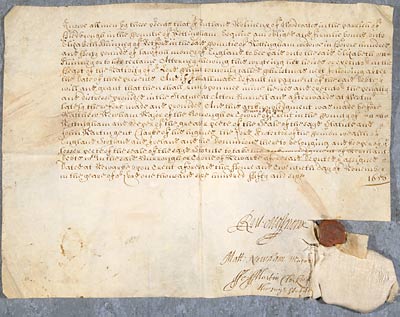Recognizance in the nature of a Statute Merchant / Staple
Statutes staple and statutes merchant were both strong forms of bond for securing the payment of money from debtor to creditor, usually involving large sums. The statute merchant dated back to the law De Mercatoribus, passed in 1285, which was itself based on the Statute of Acton Burnell passed in 1283. It was a security for a commercial debt. It had to be acknowledged in public before the Clerk of the Statutes Merchant and the Lord Mayor of London, or before two merchants appointed by the mayors of other towns. The merchant making the statute merchant was liable to have his goods seized and the rents and profits of his lands collected by his creditor if he defaulted in the payment of his debt.
The statute staple originally dated back to a law passed by King Edward III in 1353. Like the statute merchant, the statute staple was acknowledged in public before the Mayor of the Staple. In 1532 the statute 23 Henry VIII cap. 6 introduced another bond of record ('recognizance') 'in the nature' of a statute staple. This was again very similar, and was acknowledged at Westminster before the chief justices, the Mayor of the Staple, or the recorder of London.
The transparent and public nature of the declaration provided more security than a simple bond. Statute staples were also used to secure the payment of consideration money for conveyances, or the principal and interest due on a mortgage. Recognizances, statutes staple and statutes merchant were all usually cancelled by a separate document called a defeasance.
Statutes merchant and statutes staple were abolished in 1863, although they had been largely obsolete for many years before then.
Purpose
Security for repayment of money.
Features of a statute merchant, statute staple or recognizance
- 13th century-1863
- small
- written on parchment
- usually written in Latin
- deed poll (straight top edge)
- seal
Important words and phrases
Statute merchants, statute staples and recognizances look somewhat like bonds, and use some of the same phrases, e.g.
[Latin] Noverint universi per presentes ... teneri et firmiter obligari
[English] Know all men by these presents ... am held and firmly bound
However, they will have additional phrases making reference to penalties
'under the form of the statute...'
Examples
Ne D 4339 - Statute staple (Latin) from James Thornhill to William Talbot for a bond of £200; 19 Jun. 1599

View this deed
View a line-by-line breakdown of this deed
This statute staple has been signed and sealed by James Thornhill, and also by Jo. Popham. The defeasance to this statute staple is transcribed on the page relating to defeasances, and explains that Sir John Popham is the Chief Justice of England.
Transcription
[line 1] Nou[er]int Uniu[er]si p[er] p[rese]ntes me Jacobu[m] Thornhill de Tukesford in Com[itatu] Nott[ingham] yoman teneri et firmiter obligari Wil[ie]lmo Talbott
[line 2] de Walesbie in Com[itatu] p[re]d[icto] gen[er]osum ducentis m[ar]cis legalis monete Anglie solvend[is] eid[em] Wil[ie]lmo Talbott aut suo certo attorn[ato]
[line 3] hoc script[um] ostenden[i] hered[ibus] vel execut[oribus] suis in festo Natiuit[atis] s[an]c[t]i Joh[an]is Bap[tis]te p[ro]x[imo] futur[o] post dat[am] p[rese]nciu[m] Et si defecero
[line 4] in soluc[i]one debit[i] p[re]d[icti] Volo et Concedo q[uo]d tunc Currat sup[er] me hered[ibus] et execut[oribus] meis pena in Statut[o] stap[u]le de debit[is]
[line 5] p[ro] m[er]candis[is] in ead[e]m empt[is] recup[er]and[is] ordinat[a] et p[ro]vis[a] Dat[um] Decimo Nono die Junij Anno Regni d[omi]ne n[ost]re Elizabeth
[line 6] Dei grat[tia] Anglie Franc[ie] et Hib[er]nie Regine fidei defensor &c Quadragesimo Primo.
Translation
[line 1] Know all men by these presents that I James Thornhill of Tuxford in the county of Nottingham, yeoman, am held and firmly obliged to William Talbott
[line 2] of Walesby in the said county, gentleman, in two hundred marks of lawful English money to be paid to him William Talbott or his certain attorney,
[line 3] showing this writing, or his heirs or executors, on the feast of the Nativity of Saint John the Baptist next to come after the date of these presents. And if I shall make default
[line 4] in payment of the aforesaid debt I will and grant that then shall run upon me my heirs and executors the penalty ordained and provided in the Statute of the Staple
[line 5] for recovering debts for merchandise bought in the same [staple port]. Dated the nineteenth day of June in the forty first year of the reign of our lady Elizabeth
[line 6] by the grace of God Queen of England France and Ireland, defender of the faith etc.
Ne D 2478 - Statute merchant from Rutland Molyneux to Elizabeth Phinney; 24 Nov. 1656

This statute staple dates from the period of the Commonwealth [1649-1660], when England was a republic. All deeds and official documents were written in English during this time. When the monarchy was restored in 1660, the use of Latin was resumed.
Transcription
Knowe all men by these p[re]sents that I Rutland Molineux of Woodcoates in the parrish of Fledbrough in the Countie of Nottingham Esquire am obliged and firmlie bound unto Elizabeth Phinney of Retford in the said Countie of Nottingham widowe in fowre hundred and forty pounds of lawfull money of England to bee paid unto the said Elizabeth Phinney or to her certaine Attorney shewing this wryteing her heirs or executo[res] in the Feast of the Nativity of o[ur] Lord Christ comonly called Christmas next following after the Date of these presents And if I shall make Default in payment of the said Debte I will and grant that then shall run upon mee mine heires and executo[res] the penalty and distresse prouided in the Statute at Acton Burnell and afterwards at Westm[inster] lately therefore made and prouided And this acknowledgment was made before Matthew Newham Major of the Borrough or Towne of Newarke upon Trent in the County of Nottingham and keeper of the greate peece of the Seale of the sayd Statute and John Martin gent Clarke of his highnes the Lord Protector of the Com[m]on wealth of England Scotland and Ireland and the Dominions thereto belonging and keeper of the lesser peece of the seale of the sayd Statute to take the acknowledgment of Merchant Debts w[i]thin the said Burrough or Towne of Newarke aforesaid Deputed & assigned. Dated at Newarke upon Trent aforesaid the Foure and Twentieth day of Nouember in the year of o[ur] Lord one thousand sixe hundred fifty and sixe 1656
[Signatures:]
Rut. Molyneux
Matt. Newham Major
Jo. Martin Clerke of the sayd Statute
Next page: Defeasance